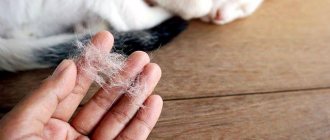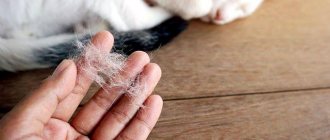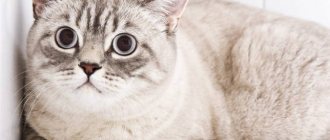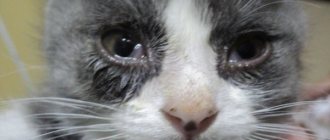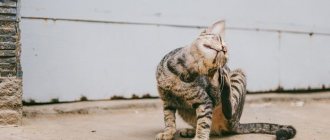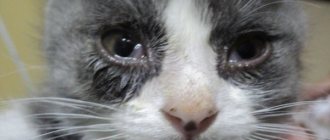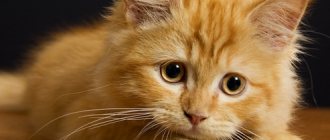Hair loss in cats is a fairly common occurrence and is caused by several factors: seasonal shedding or a signal that the animal is sick. But what should you do if your cat’s fur falls out in clumps? At this time, in order not to miss anything, you should carefully monitor your pet’s behavior and examine its skin for the presence or absence of suspicious redness or sores.
Why does a cat lose hair: 9 reasons
Among the main reasons causing intense hair loss it is worth noting:
- Seasonal shedding - in the autumn-spring months, cats actively change the density of their fur coat. In indoor individuals, molting takes longer than in outdoor individuals, lasting 2-3 months.
- Pregnancy of a cat with insufficient quality and quantity of nutrition will lead to the appearance of sparse fur. Just before giving birth, the expectant mother plucks the hair around her nipples; this is normal.
- Old age - older animals in most cases step in the thick fur of their younger counterparts.
- Stress is vitality, the resistance of cats to problems is greatly exaggerated. These animals react sensitively to changes in housing, owners, the arrival of strangers in the house, etc. Experiences affect the condition of the fur coat in a negative way.
- Lack of vitamins. With an unbalanced diet, with a constant lack of vitamins and minerals, wool falls out profusely.
- Allergy. The source of problems can be inappropriate food, care products, household chemicals, etc.
- Helminth infestation, fleas, ticks. A large number of parasites poison the body.
- Hereditary disposition.
- Skin diseases: seborrhea, folliculitis, adenitis, etc.
Correct determination of the root cause is the result of a complete, quickest possible elimination of hair loss and restoration of the pet’s health.
Care, feeding and prevention
If you identify genetic abnormalities that cannot be treated, try to limit your pet's exposure to sunlight. Follow these recommendations as preventive measures:
- Avoid stress. Before exciting events, use sedatives.
- Add vitamins to your food when feeding natural foods. Before choosing a drug, do not forget to consult your veterinarian.
- Treat regularly against parasites and follow the vaccination schedule. A person can carry the pathogen on their shoes or clothes. Even a homebody cat is not immune from infection.
- Regularly comb out dead hairs, stimulating the growth of new ones with a furminator massage.
- Bathe when soiled and use only veterinary hypoallergenic shampoos.
- Take care of the quality of your diet. Buy high-quality food of at least premium quality or fresh products.
For timely detection of hidden pathologies, veterinarians recommend taking tests every year. Elderly and weakened pets due to chronic diseases will have to visit the veterinary clinic at least 2 times a year.
If alopecia appears and your pet’s health gradually worsens, seek help immediately. The sooner the cause of baldness is determined, the greater the chance of preventing possible complications.
The article is for informational purposes only. Contact your veterinarian!
Diseases that cause hair loss in cats
Skin diseases and parasites require proper treatment under the guidance of a veterinarian. Trying to cope with the situation on your own can lead to it becoming chronic. The doctor conducts an initial examination,, if necessary, prescribes tests, scrapings, and then prescribes medications.
The most common diseases leading to severe hair loss:
- Somatic – hyperthyroidism (overactivity of the thyroid gland), hormonal imbalance, adrenal gland disorders, blood pathologies, cancer, an abundance of parasites, hypotrichosis.
- Infectious - fungal infections, dermatitis, adenitis (pathology of the sebaceous glands), seborrhea, lichen, subcutaneous mites.
Be sure to read:
What to do if a cat licks its fur to bald spots and wounds, what is overgrooming
In case of infection, it is necessary to isolate the pet from other pets, limit contact with children, and carefully observe personal hygiene. The patient is treated with special anti-fungal agents, shampoos, and the wounds are taken care of, preventing suppuration and infection. Treating animals with human drugs is strictly prohibited.
Allergy
Cat allergies are a common problem in veterinary dermatology. Recently, it has been increasingly diagnosed with increased skin sensitivity, when cats have a lot of hair coming out. The most common types of allergies include:
- Food intolerance to animal protein or a specific product (can be expressed in the form of periodic itching, scratching, loss of tufts of hair in different parts of the body and deterioration in the quality of the coat, tearing).
- Flea allergic dermatitis is a negative reaction to flea saliva in cats. It looks like severe itching, restlessness of the animal and significant uneven hair loss of the pet as a result of independent frequent licking.
- Intolerance to medications or a side effect from therapy for a chronic disease (oncology or hormonal imbalance).
In each specific case, treatment is selected individually. If you are allergic to food, the veterinarian prescribes a diet or develops a therapeutic diet. If there is a reaction to fleas, it is necessary to take all measures to eliminate them (treating not only the animal, but also the premises with special preparations all year round). And if your cat itches and goes bald due to medications, you will need to consult a veterinarian.
Attention! You should not try to independently treat allergic reactions in cats and give them human medications, such as Suprastin, Tavegil and analogues. Due to the side effects of medications and incorrectly calculated dosage “by eye,” the animal can be poisoned.
Your cat's fur is falling out: what to do?
First of all, it is necessary to analyze the situation, what lifestyle changes could provoke the situation: the food was changed, there was contact with other animals, potential carriers of infections, a child or another pet appeared in the house, which could cause stress, is it time for seasonal molting.
A growing kitten at 5-12 months actively changes its child's fur coat to an adult's one, this is normal. It is important to note the pet’s condition if it maintains its usual activity, is playful, eats well, its eyes and mucous membranes are healthy, clean, and there is no reason to worry.
If, along with the loss of fur, the cat experiences itching, scratches the skin until wounds, refuses to eat, the ears are red, the eyes turn sour, an urgent visit to the veterinary clinic is necessary.
Caring for a cat during shedding period
When a cat begins to shed, it needs special care. The animal needs to be combed daily. To speed up the process, you can give your cat professional grooming or use a furminator
In addition, it is important to more thoroughly clean the house from lost hair.
Why is it important to remove dead hair?
Villi that have fallen out and have not yet settled on your interior cause severe irritation and itching on the cat’s skin. The animal tries to lick off the excess fur or comb it out somehow.
Why is it dangerous:
- Once in the stomach, hairballs cause gastrointestinal upset and can lead to intestinal obstruction.
- Scratched wounds are entry points for infection. This can lead to various skin diseases in your pet.
- If allergy sufferers live in the house, then fur flying around the house can trigger an allergy attack.
Tips for caring for a cat during shedding
- Buy everything you need to comb out excess hair: combs, brushes or brush gloves. The choice will depend on the length of the coat and the breed of “our little brothers”.
- During this difficult period for the animal, take care of a special product (Malt-Soft paste) that helps remove hairballs from the body of the shedding comrade.
- Consult with your veterinarian which vitamins are best given during the shedding period to facilitate and reduce the shedding of your animal.
Should I bathe my cat while shedding?
There is an opinion that during the period of changing the cat’s fur, it is necessary to wash it so that it does not develop an allergy. After all, the main allergen is not wool, but particles of saliva remaining after the procedure of washing oneself with the tongue. They dry out and spread along with the dust. And washing helps speed up the process of replacing an old fur coat with a new one.
What to do when your pet is shedding
Each hair is “born” from a follicle, which is in a state of activity, forming the structure of the hair. When it grows, a resting phase begins; the hair does not lengthen, but remains in place. After 4-8 months, the hair dies and falls out. The peak of fur coat change occurs in the off-season.
Walking cats become warmer for winter, and before summer their fur coat becomes thinner. Pets can change the order of “changing clothes”: in the summer the air conditioners work in the apartment, and in the winter it becomes hot.
During this period, it is necessary to scratch the cat daily with a comb suitable for the type of fur; this will reduce the amount of hair left by the pet on furniture and carpets. Long-haired breeds (Persians, Maine Coons) develop mats without regular brushing. Cats try to keep themselves tidy and groom themselves.
Fur accumulates in the stomach, which the pet will regurgitate from time to time. To prevent a large accumulation of lumps in the gastrointestinal tract and problems with intestinal obstruction, you can give your pet special food that facilitates the removal of trichobezoars, phytomins, malt paste, or plant grass for cats in a pot.
Be sure to read:
Bald spots in cats: causes of baldness on the back, head, paws and ears
Examination by a veterinarian and diagnosis
The effectiveness of treatment depends on an accurate diagnosis. As mentioned above, you should definitely contact a special clinic. Prescribing medications yourself is very dangerous. From such “treatment” the cat may lose all its fur.
At the veterinary hospital, your pet will be able to undergo the necessary examinations. One of the main tests is a trichogram. Thanks to it, they receive information about the condition of the coat, making the first conclusions about the causes of the disease.
To care for a cat, you need to know what a furminator is for, whether cats need clothes, everything about mating cats, how to choose a comfortable carrier, whether you need to sterilize a cat, how to trim a cat’s claws, how to make toys for a cat with your own hands, how to give birth to a cat how to make a scratching post.
Did you know? Smuggling cats from ancient Egypt was punishable by death.
A cat's hair is falling out in clumps to the point of bald patches: what to do?
When shedding, the hair falls out evenly; if bald spots appear, this is an alarming signal, often accompanied by:
- runny nose;
- lacrimation;
- poor appetite;
- loss of body weight with a normal diet;
- peeling of bare skin;
- itching, anxiety, irritability;
- elevated temperature;
- bowel disorders.
In this case, it is necessary to exclude all possible causes of dermatitis: change the diet, choose a different type of tray filler, limit the use of household chemicals and be sure to show the animal to a doctor.
Ticks
However, it's not just fleas that cat owners have to worry about. Mites are common on most mammals and when their populations increase dramatically, they can cause severe itching, skin lesions, and hair loss in clumps, among other things.
Mite infestations usually occur when a cat's immune system is not functioning properly. Because of this, it is not uncommon for stressed cats or felines to already have some other disease. Additionally, if hormone levels rise or the cat begins to produce excess oil, a common consequence is an outbreak of Demodex mites, and the end result is a condition called mange.
In most cases, mite infestations are evident around the cat's eyelids, flanks, head and neck. In addition to missing hairballs, his skin will also be scaly, with lesions and scabs.
To confirm the presence and determine the type of mite causing the problem, the veterinarian will scrape the skin. Sometimes hair analysis can also help in identification. You may also need to do a urine test to rule out other conditions with similar symptoms.
The good news is that in 90% of cases, demodectic scabies goes away on its own with time. However, if it is severe, long-term medications and lime-sulfur sauces may be needed to control the condition and help the cat recover.
The cat is losing hair in clumps and has sores on the skin: causes and treatment
When a fungal infection occurs, the body becomes covered with small bald spots with round skin flakes. Ringworm is contagious to people; self-medication is strictly prohibited; laboratory tests will determine exactly what treatment will relieve the cat of the disease.
With seborrhea, the skin acquires an unpleasant odor, increased oiliness, and becomes inflamed. A scraping and blood test will help diagnose it. Erythema multiforme appears as a side pathology in oncology and other diseases. Ulcers, depression, watery blisters in the groin, armpits, profuse hair loss are its signs.
Solar dermatosis is more common in white-eared individuals; the skin turns red, peels, and later wounds appear.
Sores in a cat due to hair loss can occur when:
- alopecia areata;
- psychogenic, injection alopecia;
- folliculitis;
- sweat gland cysts.
It is not possible to diagnose the correct cause on your own; in any case, you need to consult a specialist, examine your skin and blood.
How to help a cat
Treatment is selected taking into account the general health of the pet and the factors that provoked baldness.
Medications
After determining the cause of baldness, certain groups of drugs are prescribed:
- Allergy. Immunostimulating and antihistamines are prescribed.
- Parasites. They resort to the use of antiparasitic drugs.
- Infection. Antibiotics are used, for example Amoxicillin.
- Stress. Drugs that have a sedative effect are used.
- Lichen. Antifungal agents are prescribed. The most commonly used are Ketoconazole or Griseofulvin. In addition, agents are used that stimulate metabolic processes and support immunity.
- Endocrine system disorders. Hormonal medications are indicated.
Traditional medicine
Resorting to the use of folk remedies is strongly discouraged. Often, when using them, there is a deterioration in the animal’s condition.
In addition to drug therapy, it is worth excluding potential allergens from your pet’s menu and providing him with peace. Self-medication is strictly prohibited.
Medicines
Removing parasites is the first step to fluffy, beautiful fur. First, an insecticidal treatment is carried out aimed at exterminating lice, fleas, and ticks. For this purpose, drops, sprays, and shampoos are purchased at the zoological pharmacy. They should be used strictly according to the instructions, without exceeding the concentration, dosage, or procedure time, so as not to poison the pet.
Be sure to read:
What to do if the cat sheds hair and the whole house is covered in fur all year round
The use of dichlorvos and other chemicals not intended for cats is strictly prohibited. If there are a large number of fleas, the treatment is repeated after 7-10 days. Suprastin and diazolin in the dosage recommended by the veterinarian will help relieve itching.
3-7 days after treating the external parasites, a drug is given to remove helminths. The tablet is taken in the morning, along with food, the required dose is calculated according to the cat’s weight. If worms are found in the stool after this, you need to repeat taking the drug after 10-14 days.
Alopecias that are associated with breed
Genetic predisposition to baldness deserves special attention. As a result of targeted breeding work, felinologists have developed cat breeds whose genes contain this anomaly. Sphinx, Ukrainian Levkoy, bambino, cojona, elf - the fruits of the labors of breeders. So to speak, they have beneficial alopecia.
Persian cats are particularly prone to dermatophytosis. The reason for this is probably their weak immunity. They are also more susceptible to chronic lichen than others. The trouble with this disease is its frequent relapses.
The disease is severe and seriously undermines the Persian’s health. Considering that rich and fluffy hair is the main advantage of the breed, then the tendency to baldness is a serious problem for Persian cats.
Fungal infection (ringworm)
Although there is a “worm” in this disease, it is actually a fungal infection that can be easily transmitted to people. Cats usually become ill from contact with other infected animals. From there, the infection spreads and can wreak havoc on your home, whether you have a cat or a kitten.
Hair loss in clumps is the most common symptom. A ringworm infection causes the hair to become quite brittle so it breaks, leaving behind clumps. The areas most commonly affected are around the feet, ears and face.
The skin will also show signs of infection; The ears, feet and parts of the face may appear slightly reddish, and there may also be white or gray crusts. In general, hairless skin will appear dry and flaky.
Looking for an answer to the question, why does my cat's fur fall out in clumps? this infection seemed like the biggest red flag to me. Since my cat was leaving clumps of fur behind her and some of the hairless parts were quite dry to the touch, I had to confirm the diagnosis with a vet.
Fortunately, the cat recovered quickly. To confirm the infection, the veterinarian tested a fungal skin culture. Treatment included the use of various antifungal agents such as shampoos, sprays and creams. Treatment may also include oral medications, but they were not necessary in our case.


